Notable trees
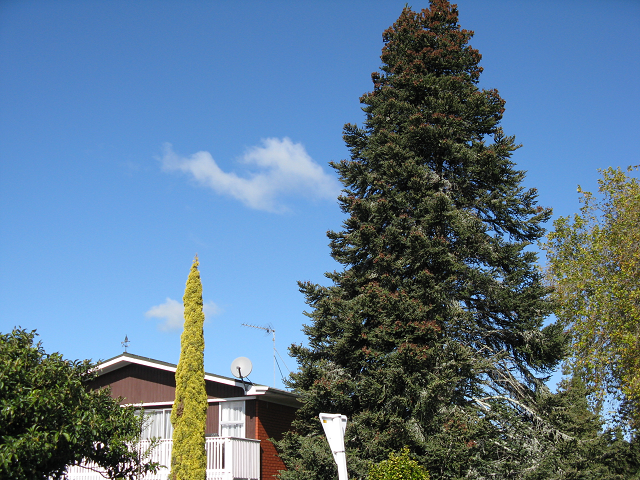
Mediterranean firs belong to two sections:
i) Section Abies (Abies bornmuelleriana Mattf., A. borisii-regis Mattf., A. cephalonica Loud., A. equi-trojani Asch., A. nebrodensis Lojac and A. nordmanniana Spach.).
ii) Section Piceaster (Abies cilicica de Lannoy, A. marocana Trabut, A. numidica Carrière and A. pinsapo Boissier). They are evergreen conifers growing up to 50 m in height, with straight trunk and pyramidal crown that later turns to flat-topped. The 3-5 buds at the apex of the shoots are conical to ovoid and generally resinous. Leaves are linear, flattened with an acute (A. cephalonica, A. borisii-regis, A. equi-trojani and A. pinsapo) or round (A. cilicica, A. nebrodensis, A. nordmanniana and A. numidica) apex.
The firs are obligate seeders, monoecious and wind-pollinated and their seeds are wind-dispersed. The cones ripen in one season, while abundant seed production occurs only every 3-5 years. They form that span a considerable altitudinal range (600-2000 m) and grow in humid bioclimates.
Mediterranean firs have distributions that are relics of mostly endemic species. The distribution area of most fir species is concentrated in the eastern Mediterranean and the Black Sea region.
Fir wood is generally considered of lesser technical value than pine wood, but is used for carpentry purposes due to its softness and workability. It is also used for general construction, paper, glued and composite wood products, veneer, plywood, panels and poles, as well as fuel wood. A fine oil or turpentine can be distilled from the crude material, while the residue forms a coarse resin named colophony or rosin. Fresh oleoresin is mainly used for pharmaceutical purposes.
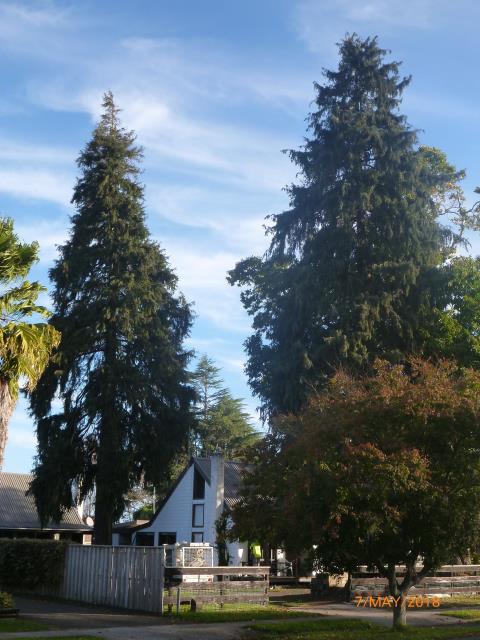
Lawson’s false cypress (Chaemocyparis lawsoniana)
These two stately, weeping, pyramidal conifers stand in Hamilton Road, probably planted in the 1970s when the Lockwood homes whose gardens they grace were built by George Veldwjik. It is unusual to see tall conifers in the gardens of Cambridge and they are all the more precious for that. Anyone who has visited Vancouver will have been impressed by the beauty of the large conifers in that city’s private gardens.
Lawsoniana were first found by Europeans growing in Oregon and NW California, from sea level to 1500m, most often along streams. It was named and introduced into cultivation in 1854 by botanists working for the Lawson and Son nursery in Edinburgh, Scotland. Normally Lawsoniana grows to about 60 m but many bigger ones have been felled in USA, some of them very old; in 1965 a still healthy tree was felled which was 75m high, over 5 m in diameter, and displaying 1755 rings.
The wood has a ginger aroma, and is light in colour, strong with a fine, straight grain; it is in demand in Japan for making coffins, and for shrines and temples, and for arrows. It is also used for making stringed instruments as it has high tonal quality.
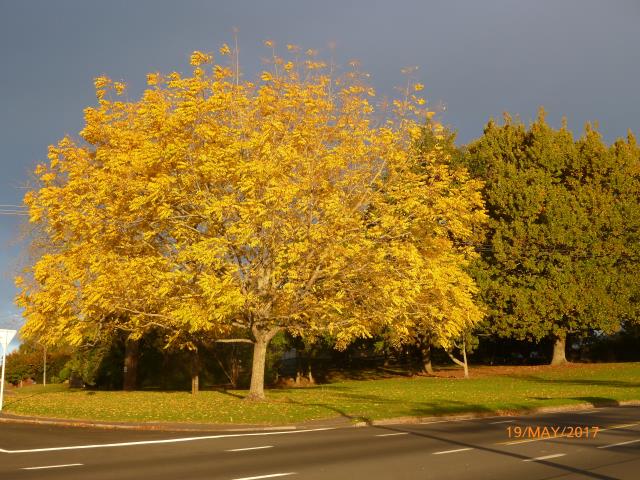
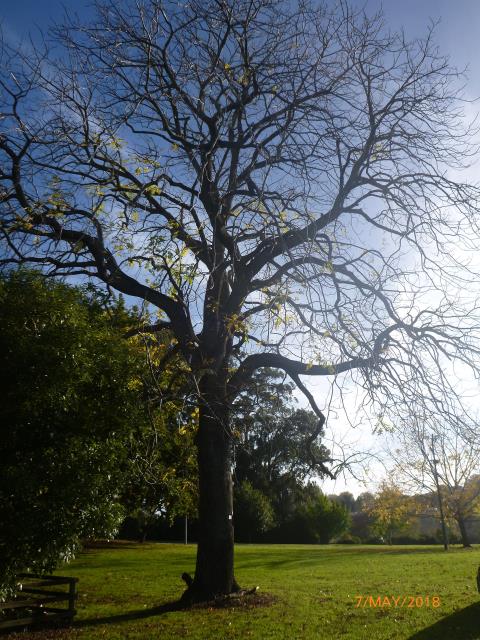
American Black Walnut (Juglans nigra). Two American black walnut trees stand near the corner of Addison and Shakespeare Streets, one a shapely young tree seen here in glorious autumn yellow, the other bare and well-befitting the description by Hugh Johnson: ‘There can scarcely be a tree that puts on less of a show. It is one of the last bare trees of spring and the first of winter …. It stands looking like a puritan about to close the theatres, [but] what it offers is of the highest quality: the best timber and the best of all nuts.’ While not as good as the nuts of the English walnut, those of the American tree can still be pickled in vinegar, preserved in sugar, made into sauces, oil and liqueurs; they are used in ice cream, and confectionery as well as in salads and meat dishes. The husks produce a very fast, yellow-brown dye, and the ground shells can be used to clean and polish soft metals, plastics, fibreglass, wood and stone. Walnut wood is dark in colour, hard, dense, tight-grained; it gives an excellent polish which is much favoured for fine furniture, and the burrs are used for turning and veneer. Because of its weight and smoothness and especially its resilience to compression along the grain, it is indispensable for gunstocks
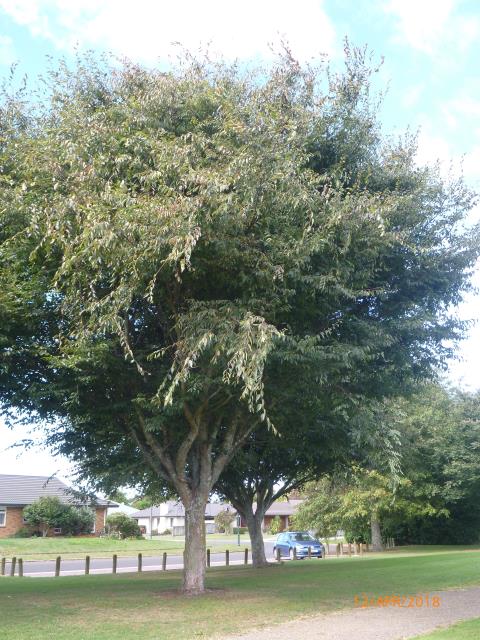
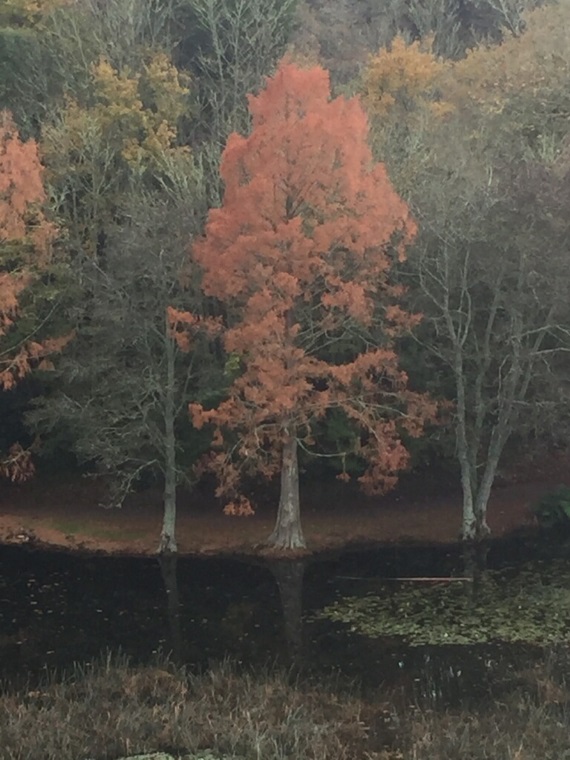
Taxodium distichum
As autumn approaches watch for these stunning trees at Lake Te Ko Utu, best viewed from the Camellia Walk above the lake. They are also lovely in spring when their new ferny foliage is a pale green, for, like the larch and the dawn redwood, they are deciduous conifers. Native to North America, they are the tallest conifers of the eastern border, dominating the swamps of Florida where they become festooned with Spanish moss as they age, but they are able to grow also in the subarctic winters of Ottawa, Canada.
Their chief desire is for a warm summer. They are long-lived trees, the oldest existing one being almost 1700 years.
To appreciate their most peculiar feature you must be standing at the fluted and flaring base which gives the tree stability in wet ground, for here you can see the unique ‘knees’ that grow up from their roots when they are near water. Once thought to perhaps provide air to the roots when submerged in water, these knees actually appear to have no means of performing this function; they are ‘just there’ like a ‘village of ant-hills’ to quote Hugh Johnson.
The wood is used for making shingles and panelling, and is highly valued for its water-resistance. Like the kauri in New Zealand, prehistoric taxodium is ‘mined’ from swamps in the south-eastern USA. In 2012 divers discovered a submerged forest of the species off the coast of Alabama. Radiocarbon dating indicated that the trees were growing more than 50,000 years ago, probably in the early glacial period of the last Ice Age.
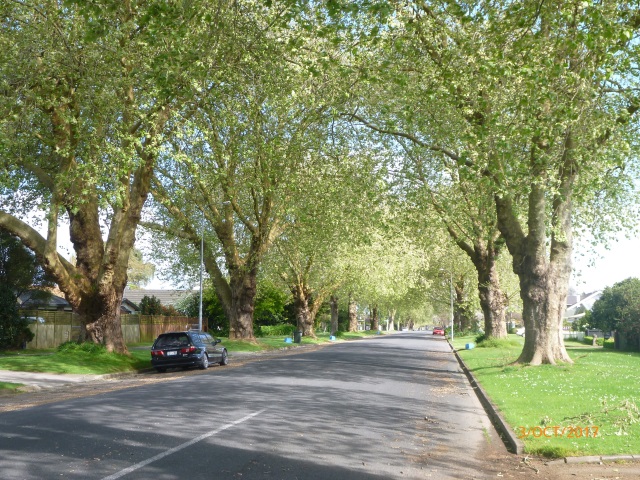
Hall St, the most beautiful street in Cambridge.
The London Plane (Platanus x acerifolia), is the quintessential urban tree that, along with the English oak, was the basis for early town planting in Cambridge. A hybrid of the Eastern plane of Turkey and Greece and the western plane of the Americas, its great attractions are fourfold: in autumn the soft yellow of its leaves, in winter the graceful arching tracery of its weeping twigs, the year-round beauty of its marbled bark, and the power of its form to ‘save town architecture from itself’. As Hugh Johnson writes, ‘streets where it is allowed to fulfil itself, as it is in countless Provencal villages, are among the most stately, be the houses mere hovels.’
This is the kind of stunning streetscape that gives Cambridge its reputation as Town of Trees, but for how much longer? As the population grows rapidly and developers grind out every last cent from their financial investment by cramming houses on to tiny sections incapable of accommodating even a modest-sized shade tree, and even the streets are too narrow for a liquidamber or claret ash, the town is in danger of becoming the Town of Shrubs and Brown Wooden Fences. But what about the social, health and environmental investment?
Long after the developers have gone, residents have to live with the results of their miserly short-sightedness. It is well past time that Council came up with a solution to this dilemma. We need a policy and planning rules that provides for at least all playgrounds, all roundabouts and all arterial routes through subdivisions to incorporate large trees such as these to provide these wonderful streetscapes for future generations. Furthermore, all greenfields developments should be obliged to retain all mature trees. This would be a start, but it is time for the Cambridge community to have serious conversations about these matters and bring pressure to bear on Council. They are supposed to represent residents, not developers.
The Cambridge Tree Trust was registered with the Charities Commission as a Charitable Entity under the Charities Act 2005 on 16 August 2007. Registration No: CC10859

